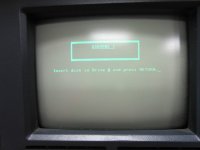ok, I did a try on my Osborne. When you fire it up, it appears the "insert a disk in drive A and press RETURN" message. Floppy drives are both idle at this point. So you put a floppy in drive A, press return, and the drive A led goes on. Then you wait for a minute (in my case) and something will happen, depending on the disk content. It could be a menu, a simple A> prompt or everything else.
this is whay you should expect at boot.
Now, since these last weeks I win the "break your vintage computer" contest (*), I had to open the Osborne-1 because three caps on the power source decided to explode (I suspect one of them exploded today, the two others are cracked but not really exploded (yet)... I'm ran out of stock, so I have to go to the local shop and buy some). So I can exactly tell you how to open it.
BEWARE: *** DO NOT TOUCH THE HIGH VOLTAGE PART IN THE CRT SECTION: HUNDREDS OF VOLTS THERE, STORED IN THE CAPACITORS, THAT'S WAITING FOR YOU!!!

***
- remove the 6 screws on the frontal (black) panel
- remove the two knobs (brightness and contrast)
- remove the black panel
- remove the 4 screws from the lower side of the case
- open the case, removing the lower half shell.
- remove the fan and the power plug plastic inserts. No need to unplug anything for now. You can do it later, when you can see better where every wire is connected to.
- take the whole computer from the half shell. You can do that simply pulling out the whole block by the metallic frame.
- to access the floppy drive, you need to remove the mainboard: 4 screws. Beware not to broke anything doing that.
(*) It seems these days every vintage computer I fire up, burns... In june and july I had to fix a Commodore PET 2001/N, a Commodore 8032, a Zenith Supersport, a Macintosh SE (that's waiting for the RAM sticks), and now the Osborne... everything I touch, breaks (Not to mention a PC ATX power source I powered with 220v instead 110v ... damn'd double voltage brazilian system, I lived in Italy for almost 40 years where there's only 220v line, so sometimes I forget to check the voltage... well, just 2 big caps and a lot of smoke and smell...)

